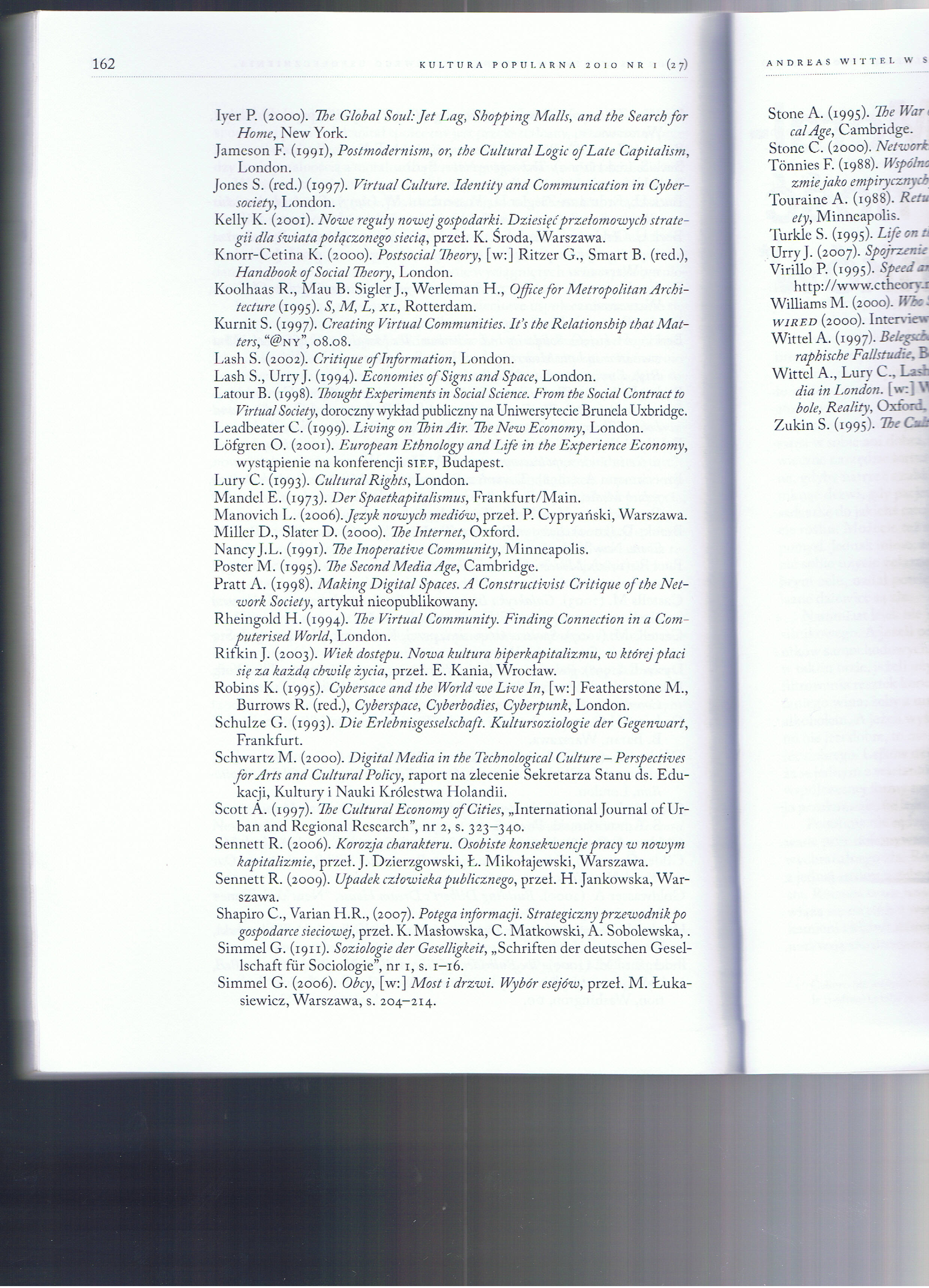CCF20111211�048

162 KULTURA POPULARNA 2010 NR I (2 7)
Iyer P. (2000). The Global Soul: Jet Lag, Shopping Malls, and the Searchfor Home, New York.
Jamcson F. (1991), Postmodernism, or, the CulturalLogic ofLate Capitalism, London.
Jones S. (red.) (1997). Yirtual Culture. Identiły and Gommunicałion in Cyber-society, London.
Kelly K. (2001). Nowe reguły nowej gospodarki. Dziesięć przełomowych strategii dla świata połączonego siecią, przeł. K. Środa, Warszawa.
Knorr-Cetina K. (2000). Postsocial Theory, [w:] Ritzer G., Smart B. (red.), HandbookofSocial Theory, London.
Koolhaas R., Mau B. Sigler J., Werleman H., Office for Metropolitan Archi-tecture (1995). S, M, L, xl, Rotterdam.
Kurnit S. (1997). Creating Yirtual Communities. It’s theRelationship thatMat-ters, “<®ny”, 08.08.
Lash S. (2002). Critiąue of Information, London.
Lash S., UrryJ. (1994). Economies ofSigns and Space, London.
Latour B. (1998). Thought Experiments in SocialScience. Erom the Social Contractto Yirtual Society, doroczny wykład publiczny na Uniwersytecie Branela Uxbridge.
Leadbeater C. (1999). Limngon ThinAir. The New Economy, London.
Lófgrcn O. (2001). European Ethnology and Life in the Experience Economy, wystąpienie na konferencji sif.f, Budapest.
LuryC. (1993). Cultural Rights, London.
Mandel E. (1973). Der Spaetkapitalismus, Frankfurt/Main.
Manovich L. (2006). Język nowych mediów, przeł. P. Cypryański, Warszawa.
Miller D., Slater D. (2000). The Tnternet, Oxford.
Nancy J.L. (1991). The Tnoperative Community, Minneapolis.
Poster M. (1995). The SecondMedia Age, Cambridge.
Pratt A. (1998). Making Digital Spaces. A Constructhńst Critiąue of the NetWork Society, artykuł nieopublikowany.
Rheingold H. (1994). The Yirtual Community. Finding Connection in a Com-puterised World, London.
RifkinJ. (2003). Wiek dostępu. Nowa kultura hiperkapitalizmu, w której płaci się za każdą chwilę życia, przeł. E. Kania, Wrocław.
Robins K. (1995). Cybersace and the World we Liveln, [w:] Featherstone M., Burrows R. (red.), Cyberspace, Cyberbodies, Cyberpunk, London.
Schulze G. (1993). Die Erlebnisgesselschaft. Kultursoziologie der Gegenwart, Frankfurt.
SchwartzM. (2000). Digital Media in the Technological Culture — Perspectives forArts and Cultural Policy, raport na zlecenie Sekretarza Stanu ds. Edukacji, Kultury i Nauki Królestwa Holandii.
Scott A. (1997). The Cultural Economy of Cities, „International Journal of Urban and Rcgional Research”, nr 2, s. 323--340.
Sennett R. (2006). Korozja charakteru. Osobiste konsekwencje pracy w nowym kapitalizmie, przeł. J. Dzierzgowski, Ł. Mikołajewski, Warszawa.
Sennett R. (2009). Upadek człowieka publicznego, przeł. H. Jankowska, Warszawa.
Shapiro C., Varian H.R., (2007). Potęga informacji. Strategiczny przewodnik po gospodarce sieciowej, przeł. K. Masłowska, C. Matkowski, A. Sobolewska,.
Simmel G. (1911). Soziologie der Geselligkeit, „Schriften der deutschen Gesel-łschaft fur Sociologie”, nr 1, s. 1-16.
Simmel G. (2006). Obcy, [w:] Most i drzwi. Wybór esejów, przeł. M. Łuka-siewicz, Warszawa, s. 204—214.
Wyszukiwarka
Podobne podstrony:
CCF20111211�002 116 KULTURA POPULARNA 2010 NR I 2 ~ rżymy obiekty medialne służące późniejszemu wspo
CCF20111211�004 118 KULTURA POPULARNA 2010 NR I (27) do sieci osobista pamięć niebezpiecznie sprzęga
CCF20111211�006 120 KULTURA POPULARNA 2010 NR I 11
CCF20111211�006 (2) 10 KULTURA POPULARNA 2010 NR I (2 7) raport: młodzi i medi 10 KULTURA POPUL
CCF20111211�009 122 KULTURA POPULARNA 2010 NR I technicznej i kulturowej w kontekście cyfrowej fotog
CCF20111211�010 124 KULTURA POPULARNA 2010 NR lir V A N DIJCK ZMEDIA1 są wyraźnie wykorzystywan
CCF20111211�012 126 KULTURA POPULARNA 2010 NR I JOSE V A N DIJCK ZMED1ATY 126 KULTURA POPULARNA
CCF20111211�014 128 KULTURA POPULARNA 2010 NR I (2 cyjnej atrakcyjności kieszonkowych aparatów cyfro
CCF20111211�014 (2) 18 KULTURA POPULARNA 2010 NR I (27) aport: młodzi i med 18 KULTURA POPULARN
CCF20111211�016 130 KULTURA POPULARNA 2010 NR I jako nadrzędne narzędzie pamięci, w szczególności w
CCF20111211�016 (2) 20 KULTURA POPULARNA 2010 NR I (27) Dla naszych młodych współpracowników najpełn
CCF20111211�018 (2) 22 KULTURA POPULARNA 2010 NR I (27) * a port: młodzi i mediAsymetryczna Rów
CCF20111211�020 134 KULTURA POPULARNA 2010 NR I (27 wanie naszej przeszłości. Osobista fotografia mo
CCF20111211�022 (2) 26 KULTURA POPULARNA 2010 NR >:rt: młodzi i media jest niemal jednoznacz
CCF20111211�024 138 KULTURA POPULARNA 2010 NR I (27 Andreas Wittel yy StfOnesiecio
CCF20111211�024 (2) 28 KULTURA POPULARNA 2010 NR I (2 cowników nierozdzielne, stanowią część tej sam
CCF20111211�026 140 KULTURA POPULARNA 2010 NR I (27) ani też odsłanianiem modeli relacji społecznych
CCF20111211�026 (2) 30 KULTURA POPULARNA 2010 NR młodzi i medi 30 KULTURA POPULARNA 2010 NR&nbs
CCF20111211�028 142 KULTURA POPULARNA 2010 NR i (27J ANDREAS W1TTEL W S WM. i ..4. L." ZA Ab
więcej podobnych podstron